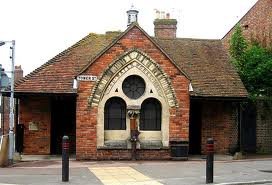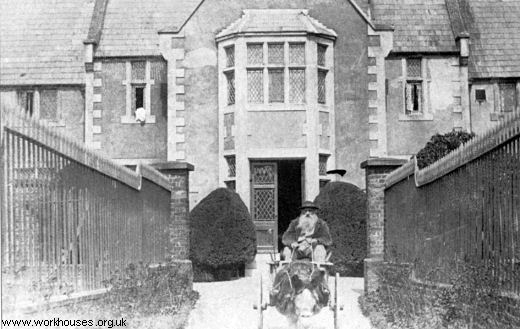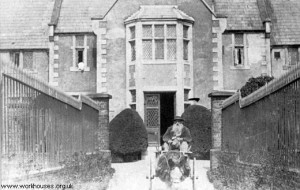Late Victorian & Early Edwardian Rye
By “Rya”
Pauperism remained an unresolved social problem at the opening of the twentieth century. Social reform in this county was confined to filing the most glaring gaps in the existing social system. The bed-rock of social provision was to be found in the Poor Law, first enacted in the time of the Tudors, and re-enacted in 1834. Administered locally by Boards of Guardians and financed from the local rates, the Poor Law provided a minimum subsistence under conditions which were deliberately designed to deter all but the utterly desperate from applying for it. It is little wonder, therefore, that the poor feared the day when, through ill health, misfortune or old age, they would no longer be able to earn their living for, unless they had been extremely thrifty or possessed children who were in a position to help, the workhouse was the only place for them.
The Workhouse
Once in such a house, the inmates found themselves placed under the jurisdiction of a master and matron. Forced to wear the workhouse uniform, none could leave the premises except on special occasions. Entertainments and treats were provided from time to time by well meaning local men and women, but freedom and liberty – the twin concepts of a full and complete life – were denied. Many of the town’s leading men served on the Board and introduced many reforms, though these were of necessity limited in scope as the rates would not have borne the cost. In 1892 Mr. Lord, one of the Guardians, attempted to persuade the Rye Board to allow well-behaved men and women, who had entered the house through misfortune or no fault of their own, to wear ordinary dress when they were granted leave of absence instead of the workhouse garb, which he described “as a badge of misfortune, or, possible, disgrace”. The privilege was to be forfeited by future misconduct or disobedience to the master or matron. Voices were raised against discriminating between the well-behaved and the others and the proposal was adopted – after much discussion – without the offending rider. When a crippled man, aged 26, who had been in the workhouse for six years, asked for a “testimonial to Messrs. Day and Martin in order that he might obtain a box and brushes, and earn an honest living as a boot-clack”, the Board readily granted his request. The world was still, as Disraeli had remarked, for the few – the very few. Sometimes the proceedings were enlivened by a little humour. In support of an application for increased relief, a well-known Rye character stated that she was 609 years old!
Life outside the workhouse was far from easy for, although prices were low, so, too, were wages. When unemployment or illness struck, there were no welfare services, such as exist in the modern totalitarian state, to come to the rescue. Succour in adversity was provided by the comparatively well-to-do classes (much maligned by certain politicians today), who believed they had a responsibility for the welfare of the less fortunate. An outstanding example is provided by John Symonds Vidler whose generosity knew no bounds. The following description of the re-opening of the soup kitchen in 1907 well illustrates the need and the way it was met in adverse times. “The Rye Council Authorities have made arrangements for the distribution of soup and bread to the poor and unemployed of the town.
On Saturday the Town Crier was busy visiting necessitous districts, and announcing to the crowds that gathered at the tintinnabulary call of his bell that tickets for soup and bread would be distributed to deserving cases at the Town Hall in the evening.
At six o’clock sharp, on the evening in question, a large and representative party of the fishing and labour fraternity, who had been thrown out of employment and were otherwise afflicted by hard times, assembled at the Town Hall. The cases were heard by officials who made orders for the necessary distribution of bread and soup. No less than 122 tickets were given, and it was decided that the soup kitchen in Cinque Ports Street should be opened twice a week, on Tuesdays and Fridays
During The Cold Weather
Accordingly, great preparations were made at the Soup Kitchen headquarters, which buildings, we believe, was formerly used as the Town Water Pumping Station, the pumping power of which was “generated” by a couple of horses harnessed to mechanical contrivances.

Two large coppers, each capable of holding 70 gallons of soup, were cleansed, the fuel was got ready, as also were the extensive fireplaces. For four solid hours on Monday a couple of muscular Ryers kept continually “on the go” peeling potatoes, carrots, parsnips, turnips and onions.
A large quantity of split peas that was also to be used in the soup was soaked in water for the greater part of 24 hours whilst the joints of meat and bones were cut up small.
All night and all morning until eight o’clock when the Kitchen was declared opened, did the two brawny impromptu cooks attended to…..
The Roaring and Crackling Fires ….
….and to the steaming cauldrons. Unceasingly did they manipulate the “stirrer” and spoons, some four feet in length.
At the opening time, and perhaps a little before, the soup was bubbling and gently steaming, and was declared by the connoisseurs to be “ready”. On the doors of the building being thrown open the savoury odour of soup permeated the neighbouring streets, from which came, scurrying and running small boys and girls, carrying such handy receptacles as ewers, water cans, pots, basins, buckets and other articles which were well worthy of being exhibited in a curiosity shop.
A number of women and men, mostly past the prime of life, and some past the allotted three-score and ten years, also came, and in about an hour’s time no less than 70 gallons of bread, and 95 gallons of soup were distributed. There were altogether 153 applicants.
The soup was very good, and did credit to the pair of hard working cooks, who were assisted in the distribution of the hot food and bread by the Mayor (Councillor Kingsnorth Reeve). Alderman Jarrett, Alderman Neeves, Councillor Gasson, Mr. Edwin Dawes, etc.
The soup was made with the following ingredients: 2 bushels potatoes, 1 bushel carrots, 1 bushel turnips, 1/2 bushel parsnips, 1/2 bushel onions, 10 gallons split pease, 40 lbs. meat, and about 35 Ibs of bones.
The meat and bones were provided by Messrs. Ashbee and Neeves. Several hundred-weights of coal and a bushel of wood were used in cooking the soup”. While life was undoubtedly difficult for the poor, it would be utterly wrong to assume that it was not enjoyed. Pleasures were mostly of a simple nature and often home-made. Many a child thoroughly enjoyed such treats as a journey to the sands at Camber on the steam-driven tram, especially if they rode in the waggons, which were added to the train in the summer months. Concerts were frequently held in various parts of the town. That Ryers predominated in such performances is evidenced by a concert given at the Wesleyan Sunday School in 1907, the programme of which was as follows; “Pianoforte duet, the Misses D. and B. Moon; cantata, “The Mission of the Flowers, Children; solo, “The Land of Nod”, Miss Eva Malpass; musical sketch, Mr. Fred Neeves; solo and chorus, “The old woman who lived in her shoe”, Miss Birdie Moon; solo, “Little Maid and her bonnet”, Miss Lily Bryan; recitation, Mr. Fred Neeves; chorus, “Four – and – Twenty Blackbirds”, Children; chorus, “Could we but rule”, Young People; song, “Wynken, Blynken, and Nod”, Misses E. Harvey, W. Mann and M. Morphy.
Tableaux;- Jap’s Tea Party, the Misses Harvey and D. Moon; Spring , “Crowning of the May Queen”. Summer, “A Picnic”; Autumn, “Harvest Field”: Winter “Santa Claus”.
Queen of Hearts;- First scene, “Queen making tarts” Miss Ethel Neeves; second scene, “Knave steals the tarts,” Mr. Fred Neeves; third scene, “King beating knave”, Mr. Thompson; Transformation Tableaux (performers, 25 children and 15 adults). Miss Hinds acted as accompanist on the piano.”
“The signing of the concerted pieces and solo were particularly good”, wrote one local commentator, “as also were the illustrative actions. The Suffragettes” song, “Could we but rule”, caused much laughter and was loudly applauded”.
Drunkenness and Lawlessness
Nuisances abounded in the town at the opening of the 20th. century. Drunkenness and lawlessness were by no means rare with cheap beer and a multiplicity of inns. Tramps and the “Jolly Sailor” inn turned that part of the town into a veritable slum, which no respectable lady would have visited. The year 1901, in which no less than ten inns were closed, witnessed the end of the “Jolly Sailors” career.
A double menace to public health and safety was represented by the slaughter houses behind the High Street and the cattle being driven to them through the streets. Although the butchers concerned contended that their slaughter houses were in a faultless sanitary conditions, this was certainly not the option of the public-spirited sanitary inspector, Joseph Adams. The alternative was to build a public slaughter house outside the town at the ratepayers’ expense, which was unacceptable and, consequently, nothing was done.
Nuisances of this nature pale, perhaps, into relative insignificance before the ever present danger from fire and its usually serious consequences. Early in 1907 a serious conflagration broke out at the mineral water factory W. E. Colebrookes – at the Strand. A contemporary newspaper gives the following account of the event. “It appeared that at 3.30am. Police-Constable Osborn was passing by the premises, when his attention was called to smoke and fire issuing from a storehouse-a wooden structure.
Fire at Colebrookes
The alarm was promptly given, and the local Fire Brigade, under the command of Captain Gasson, smartly arrived on the scene of action.
The building contained several tubes of carbonic acid (used for aerating mineral waters), besides many thousands of mineral water bottles. The heat was so great that before the fireman arrived a LOUD EXPLOSION occurred, and one of the tubes was hurled with considerable force over the Tillingham River, and in its fall smashed through the roof of a stable (belonging to Mr. J. S. Vidler), about 200 yards from the actual scene of the fire. Several windows of neighbouring houses were shattered, but, happily, no one was injured.
Meanwhile the fireman were hard at work fighting the flames. The fire engine was not brought into requisition, there being a good supply of water. The hoses were quickly connected with the water mains.
The flames were greedily licking the doomed building and dense smoke was issuing. Volumes of water were poured over the conflagration, but the strong east wind only fanned the fire, and threatened to communicate it to the adjoining buildings, which were all more or less of a very inflammable nature.
The intense cold greatly interfered with the work of FIGHTING THE FLAMES. At the time it was freezing hard, and the water which drizzled on the firemen froze in solid lumps on to their clothes. However, an hour’s determined work saw the fire well under hand, and half an hour later it was extinguished.
The origin of the fire is not known, The building was not insured, and the damages are estimated at about £150.
The full Fire Brigade attended, and the Officers, Captain H. J. Gasson and Lieut. Huggett, and the men are to be heartily congratulated on their smart turn-out.”
New Grammar School Building
Many were the changes that took place in the town in these years. The old grammar school building was replaced by a new school in 1907. The old building was offered for sale to the town in 1902, but at a postcard vote taken of the ratepayers the offer was rejected and “the opportunity lost”, as L.A. Vidler has written, “of putting it to some useful public purpose”. In the event it was bought by Mrs. Brocket, who generously allowed the free use of it to the school until her death in 1906, when it was purchased by Kingsnorth Reeve and vested in the next year in a company named “Old Rye School, Ltd”. The old grammar school is of great interest for “the facade of this building”, as Geoffrey S. Bagley has written, “is one of the most distinguished architectural features in the town; a rendering in brickwork of classical features showing a competence that would not be found in local labour. It is possible that a London artisan builder or journeying workman from Flanders – Rye had a direct trade with that country in 1636 – was employed in the building”. The foundation stone of the new school was laid in 1907, the site of which had been given by the Corporation. Girls were admitted for the first time on equal terms. By 1914 the number of pupils had increased to about 50 boys and 26 girls.
New Catholic Church
“No Catholic Church”, writes Kenneth M. Clark, “had darkened the glory of the Anglican edifice in the nineteenth century, yet it was during that century that Rye – like the rest of the country-had witnessed the revival of the Old Faith”. For many years the town had been served by a priest from Hastings” with a very poor result; first on account of the locality which is very objectionable, and the little room (in a fisherman’s cottage outside the Land Gate) where Mass is said quite unfit for such use”. The only way to resolve the problem was to raise the necessary funds to build a church. In August, 1900. St. Walburga’s Church in Watchbell Street was opened. The Corporation was respectfully invited to the opening ceremony. Councillor Neeves opposed acceptance, saying “I think we, as Protestants, do not recognise the Roman Catholic religion in this country… It is so opposed – it is not our religion. I am not a prejudiced man at all; I am very broad minded. But surely the religion our fathers have suffered for – ” At this junction, Neeves’ peroration was abruptly terminated by the Mayor (Councillor F. Jarrett), who had no desire to see a religious controversy develop among the councillors. In the event, the Corporation duly accepted the invitation. But if the Old Faith had returned many problems were to remain unresolved until the arrival of the first of the Greyfriars, Fr. Bonaventure, in 1910. Thereafter it grew from strength to strength in a much more tolerant town.
In the summer of 1907 the South Eastern and Chatham Railway Company introduced a motor train service between Rye and Hastings. These trains called not only at the usual stations of Ore and Winchelsea, but at the intervening halts at Three Oaks, Guestling and Snailham Crossing for the convenience of people wishing to view the countryside around Brede, Icklesham and Udimore. From July to September five trains each way on weekdays at regular intervals of about two hours. “We feel confident that this service will fill a want”, stated the Hastings Station master, “there are not many means at present by which people can get into the country for the day, because if they go by coach they have no conveyance by which they can return.” At the time the new service proved to be a boon.
On 13 July, 1908 the local undertaking the Rye and Camber Tram- celebrated its thirteenth birthday with the opening of the extension to Camber Sands. The new terminus was an open raised platform utterly devoid of shelter. Situated as the timetable quaintly stated, “far from the madding crowd”, it was indeed an ideal spot for picnics, with the sands stretching for miles, firm in character and golden in colour. Would one not wish to turn the clock back to those days, when Rye was a closely knit community that had not been shaken to its very roots by the devastation and utter waste of life in the First World War? The extension was built almost entirely on an embankment and terminated in a run-round loop. The old terminus was renamed Golf Links.
What did the future hold? True there were many unresolved domestic problems, but then the new Liberal Government, with its enormous legislative programme, seemed certain to succeed in its most ambitious hopes. No one would have guessed that only a few years remained before an inextinguishable dark would fall on the splendour of Imperial England. In the event this was perhaps, a good thing.
Reprinted in February 2005 issue of “Rye’s Own”

